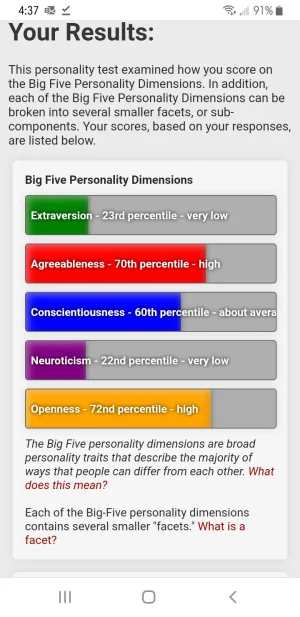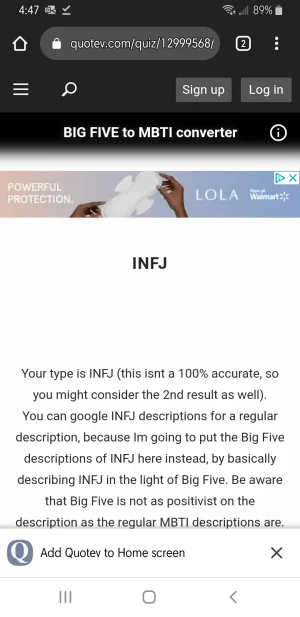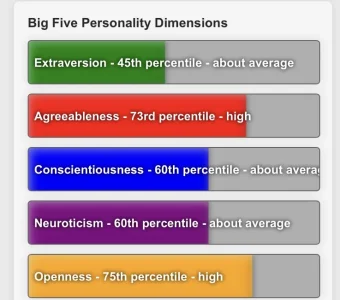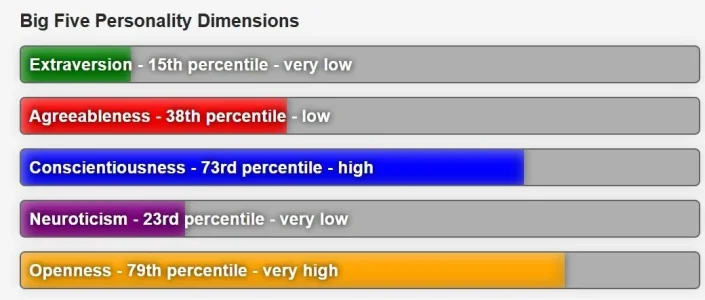BIG FIVE to MBTI converter quiz
Vendrah
ENFP
Your type is ENFP (this isnt a 100% accurate, so you might consider the 2nd result as well).
You can google ENFP descriptions for a regular description, because Im going to put the Big Five descriptions of ENFP here instead, by basically describing ENFP in the light of Big Five. Be aware that Big Five is not as positivist on the description as the regular MBTI descriptions are, but ENFP type is seem as a little bit overly positive on Big 5 lens.
SCUAI (ENFP, Low Neuroticism)
life of the party, not bothered by disorder, not afraid of doing the wrong thing, often late, level emotions, not afraid to draw attention to self, worry free, people loving, prefers unpredictable to organized, fearless, not apprehensive about new encounters, likes philosophical discussions, disorganized, not easily annoyed, not a perfectionist, enjoys danger, comfortable in unfamiliar situations, anxiety free, always joking, not very private, very curious, not embarrassed easily, adventurous, flexible, narcissistic, trusting, easy to get to know, easy to satisfy, likes crowds, ready to act on the spot, not a bad loser, outgoing, thrill seeker, not easily discouraged, optimistic, laid back, open to new experience, slow to judge others, thinks fun is the most important think in life, socially skilled, easily talked into doing silly things, rarely prepared, willing to take risks, adjusts easily, passionate about causes, willing to explain things twice, spontaneous, relaxed, believes in universal harmony, eager to soothe hurt feelings
SLUAI (ENFP, High Neuroticism)
easily confused, often late, rarely prepared, passionate about better the world's condition, easily distracted, wild and crazy, longs for a stabilizing relationship, prone to addiction, often rushed, show off, prone to worry, frequently loses things, does not accomplish work on time, acts without thinking, not good at sports, easily hurt, scatter-brained, very curious, spontaneous, not too hard working, aware of how the color and lighting of a room affects their mood, believes in a supernatural source of peace and love, can be talked into doing silly things, unpredictable, asks many questions, interested in others, upset by the misfortunes of strangers, believes in the importance of art, prefers have many different interests to just one, does not often know why they do things, moody, likes to be the center of attention, swayed by emotions, focuses on fantasies more than reality, acts without planning, becomes overwhelmed by events, able to disregard the rules, not good at saving money, eager to sooth hurt feelings, afraid of doing the wrong thing, can become aggressive when they feel hurt
ENFP can be seem as a merge between these types description (these can also works as a set sub-types of ENFPs):
FANCIFUL/IMAGINATIVE TYPE (Low C, High O)
Fanciful/Imaginative Types are unconventional nonconformists who pride themselves on being different from others. They are not so much openly antisocial and disruptive in their behavior as they are fanciful, impractical, and unconcerned about the general welfare of others. They are described by others as complex, imaginative, and critical.
DEBONAIR TYPE (High E, High O)
Debonair Types are intelligent extraverts. In their worldliness they can be quite witty and charming. They have a flair for the dramatic, and can be histrionic and theatrical. People are naturally attracted to debonair types, but if a debonair type dislikes somebody, he or she can swiftly cut that person to the quick. Therefore, this type is generally described with positive terms such as enterprising, eloquent, forward-looking, confident, and sexy, but can also be described as critical, candid, and intense.
IMPULSIVE TYPE (High E, Low C)
Impulsive Types are exhibitionists who act outrageously in order to attract attention from others. Often rather unconventional, risk- taking, flamboyant, they also need and enjoy social stimulation. They are described by others as talkative, outgoing, changeable, blunt, and outspoken.
PERSONABLE TYPE (High E, High A)
Personable Types enjoy interacting with other people. Personable individuals frequently experience and express positive emotions and are therefore typically well-liked by others. They derive satisfaction from helping, and are well-suited for careers in the helping professions (counseling, teaching, nursing, human services). They are described by others as cheerful, confident, sociable, vigorous, enthusiastic, and friendly.
TOLERANT TYPE (High A, High O)
Tolerant Types are open to, and accepting of, differences in other people. They care about the feelings of others and tend to take their opinions into account when making decisions. Their social skills are reasonably well-developed and they normally relate well to others in both co-worker and supervisory roles. They are described by others with such terms as good-natured, empathic, genial, tactful, diplomatic, calm, and poised.
OTHER-DIRECTED TYPE (High A, Low C)
Other-Directed Types are easy-going, somewhat lazy drifters who lack strong opinions and principles. They prefer simply to hang out with their social crowd. They are described by others as relaxed, outgoing, and unlettered.
Sources of these descriptions:
similarminds.com/global5/sloan.html
www.personal.psu.edu/faculty/j/5/j5j/IPIPNEOdescriptions.html
Here are some facts you wont find that easily on internet about ENFP (some of these are from my personal search that does not follow soft-scientific standards):
- The most common intuitive type in the world. The only type that it is more common than its sensor cousin.
- Most likely type to be marked as “best friend” by other intuitive types (tied with INFJ).
- Most T of feeler types, tied with INFJ.
- This type tends to diverse and decentralize its use of cognitive functions.
- Most Perceiver of all types.
- 6.5% of world´s population (based on 21 countries,2012-2020) and 7.5% of US population (2018).
My own description of Ne and Fi (pair for ENFP):
Ne:
typologytriad.wordpress.com/cognitive-functions/extraverted-intuition/
Fi:
typologytriad.wordpress.com/cognitive-functions/introverted-feeling/
Countries with most ENFPs:
1 - Japan (14.2% of population) (most common type)
2 - Ireland (12%) (2nd most common, the 1st is curiously ISTJ)
3 - Sweden (10.7%)
3 - South Korea (10.5%) (2nd most common, the 1st is curiously ISTJ)
Countries with least ENFPs:
1 - Thailand (1.8%)
2 - China (4%)
3 - Mexico (4.2%)
Countries and MBTI types:
typologytriad.wordpress.com/mbti-population-by-country/
Most common type in ENFPs friends/best friends list (based on several "[ENFP] What is your best friend?" threads among several different websites/forums):
1 - INFP (21%)
2 – Another ENFP (15%)
3 - ENFJ (12%)
ENFPs on Enneagram:
Most common: Type 7 (39%)
Usual: Type 2, Type 4 and Type 9.
Rare: Type 3, Type 5 and Type 8.
Incompatible: Type 1 and Type 6 (phobic).
ENFPs on borderlines:
This type commonly has a E/I and a F/T borderline and having at least one borderline is very common. From 16 ENFPs on Dario Nardi test, only 3 had clear preferences, 12 had one borderline and 2 had two borderlines (both borderline on E/I and F/T). 11 had E/I borderline and 5 had F/T borderline, and no one had a N/S or a P/J borderline.
MBTI / Enneagram / Big 5 connections:
typologytriad.wordpress.com/mbti-enneagram-big-5-correlations/
Borderlines:
typologytriad.wordpress.com/2020/07/12/tcf-series-5-what-is-the-most-thinker-of-all-thinkers-is-there-an-intuitive-sensor-all-dichotomies-covered/

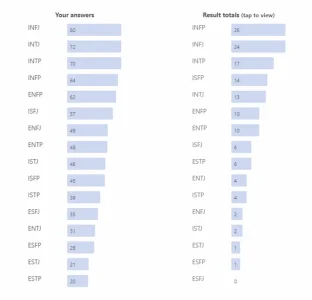

 HE DIDN'T SAY THAT OMG
HE DIDN'T SAY THAT OMG
